Analysis of heart rate variability in medical students with different types of hemodynamics and body mass index values
Aннотация
Background: Adaptation of medical students to high school education is a serious medical and social problem. Serious stress, unbalanced diet and physical inactivity may result in disorders of the body’s regulatory systems, as well as metabolic disorders, which may contribute to the development of cardiovascular diseases. Existing hemodynamic heterogeneity of the population also contributes to the response of the body to stressful factors. The aim of the study:To evaluate the specifics of heart rate variability (HRV) in medical students with different types of hemodynamics and body mass index values. Materials and methods: 170 second- and third-year students of the North Ossetian Medical Academy were enrolled in an observational study during the time of their preparation for exams. Blood pressure and anthropometric parameters were measured, and HRV (short-term recordings) was analyzed. After ranking the students by the types of hemodynamics, HRV parameters were estimated depending on the body mass index values. Results: The majority of medical students enrolled in the study were shown to have a eukinetic type of hemodynamics (60.6%), whereas 36.5% and 2.9% had hypokinetic and hyperkinetic types of hemodynamics, respectively. ANOVA on ranked data showed intergroup differences in both temporal and frequency HRV variables. The students with hypokinetic and eukinetic hemodynamics demonstrated higher values of MxDMn, HF, Мо, SDNN, RMSSD, pNN50%. In the group with hyperkinetic hemodynamics, TP (843.89 (397.24; 1665.36)) was less than half of that in the other groups, while SI (336.28 (194.07; 404.51)) and RSAP (6.50 (5.00; 7.00)) were higher compared to the other groups. Conclusion: Medical students demonstrated an increase in the tone of the sympathetic autonomic nervous system and a predominance of central regulatory mechanisms over autonomic ones, which was particularly evident in students with the hyperkinetic type of hemodynamics. Some HRV parameters worsen with higher BMI in students with different types of hemodynamics. Higher frequency of eukinetic and hypokinetic types of hemodynamics (which are less energy-consuming) may indicate a contribution of adaptive mechanisms of the cardiovascular system functioning during the period of preparation for exams
К сожалению, текст статьи доступен только на Английском
Introduction. The heart is a sensitive indicator of all events happening in the body. The rhythm of its contractions, which is regulated via the sympathetic and parasympathetic nervous system, is very sensitive to any stress factors. HRV is a method of evaluation of the overall activity of regulatory mechanisms that maintain the cardiovascular homeostasis, neurohumoral regulation of the heart, and the relationship between the sympathetic and parasympathetic parts of the autonomic nervous system. HRV parameters may be used as markers of neurocardial function involving both the heart and the brain [1]. HRV parameters may be used to evaluate adaptive capabilities of the body, as well as for the diagnosis and prognosis of different body conditions: normal, preclinical and abnormal. Overstrain of adaptation mechanisms and resulting autonomic dysfunction form the basis of a preliminary stage of many somatic disorders [2, 3]. HRV research provides insight into a wide range of psychological and physiological processes [4].
Adaptation of medical students to high school education is a serious medical and social problem. Serious stress, unbalanced diet and physical inactivity may result in disorders of the regulatory systems of the body, as well as metabolic disorders, which may contribute to the development of cardiovascular diseases.
Determination of the type of hemodynamics in healthy subjects and patients with cardiovascular disorders is both of obvious practical value and scientific interest. Adequate hemodynamics is a necessary condition for normal function of the internal organs. The parameters characterizing the function of the heart and blood circulation help evaluate the patient’s condition and the effectiveness of therapeutic interventions. The impairment of systemic hemodynamics results in significant worsening of the function of all vital systems and organs. There are 2-4-fold differences between the maximum and minimum values of many hemodynamic parameters studied under the conditions of basal metabolism as evidenced by numerous studies of the cardiovascular system in healthy subjects. This is equally typical for the stroke volume (SV), cardiac output (CO) and total peripheral vascular resistance [5]. The variability of hemodynamic parameters is observed in childhood, suggesting its genetic origin [6]. Thus, there is a hemodynamic heterogeneity of healthy subjects and therefore certain hemodynamic types might be distinguished in the population. Three main types of circulatory regulation are currently distinguished: hypokinetic, eukinetic, and hyperkinetic. The difference is in activation of the central or peripheral circulation, or both. All types of hemodynamics are normal variations, however, they differ in blood circulation parameters and the mechanisms of neurohumoral regulation. The classification of these types is based on the results of previous studies [5, 7].
The aim of the study. To evaluate the specifics of heart rate variability in medical students with different types of hemodynamics and body mass index values.
Materials and methods. 170 second- and third-year students of the North Ossetian Medical Academy were enrolled in an observational cross-sectional clinical study. The study was conducted in the spring and summer during the educational process and preparation for exams. The conditions of the study were explained to the students, and all participants signed an informed consent form to participate in the study. The conduct of the clinical study as part of a research project was approved by the Ethics Committee of the Institute of Biomedical Investigations – an Affiliate of the Vladikavkaz Scientific Center of the Russian Academy of Sciences (Protocol No. 7 of February 20, 2019), link to repository ClinicalTrials.gov (NCT04851080). The study sample included 133 female (mean age = 20.1±0.07 years) and 37 male (mean age = 20.7±0.24) students. Heart rate (HR) and blood pressure (BP) were measured in the sitting position after 5-7 min of rest. The measurements were conducted twice with a 2-minute interval; in case of BP differences >5 mm Hg, an additional measurement was performed. The arithmetic mean was used to report the BP value. The exclusion criteria were known cardiovascular disorders. For ranking by the types of hemodynamics, the following parameters were estimated according to well-known formulas, based on available data: pulse pressure (PP, mm Hg); mean hemodynamic blood pressure (BPmean, mm Hg); stroke volume (Starr formula) (SV, mL); cardiac output (CO, L/min).
A previous classification of the types of central hemodynamics was based on the cardiac index (CI), which does not take into account gender and age; moreover, CO has been shown to change with age due to changes in the oxidative processes of the body, the development of arteriosclerosis and atherosclerosis. According to some researchers, CI cannot be considered a strictly constant value for persons of different age and sex, and its mean value cannot be used to estimate the cardiac output value proper [8]. Yu.E. Teregulov suggested a method for determining the type of hemodynamics based on the estimation of the percent deviation of the measured CO from the proper CO (PCO, l/min) using the following formula: %CO = 100 * (CO - PCO)/PCO [8]. Proper CO was calculated using the formula: PCO (l/min) = BMR/281, where BMR (kcal) is the proper basal metabolic rate calculated using the Harris–Benedict equation taking into account the age, sex, body mass and height. Consequently, the following algorithm was suggested for specifying the types of central hemodynamics based on CO and estimated PCO values:
• hyperkinetic type: %CO > 50%
• eukinetic type: -10% ≥ %CO ≤ 50%
• hypokinetic type: %CO < -10%
We applied this approach to the classification of the types of central hemodynamics in our study. Mean body mass in all students enrolled: 61.6±0.91 kg (male students: 75.2±2.09; female students: 57.8±0.72). Body mass index (BMI) values were calculated using the following formula: BMI = m/h2, where m = body mass (kg), h = height (m), followed by ranking (18.5 ≤ BMI < 25 normal values; BMI ≥ 25 overweight).
Heart rate variability (HRV) in the study groups was evaluated using a Varicard 2.51 hardware and software complex. The recording was performed in the sitting position for 5 min (Short-term Recordings) in silence and under dim lighting after a 5-7 minutes rest. RR-intervals were analyzed using software and by visual inspection for artifacts and arrhythmias; in these cases, they were excluded from the analysis. In accordance with the guidelines of the European Society of Cardiology and the North American Society of Pacing and Electrophysiology, we studied two groups of HRV parameters: temporal variables (Time Domain Methods) and frequencies (Frequency Domain Methods) [9], as well as some additional parameters [10]. The main temporal variables included heart rate (HR, bpm), mean of normal-to-normal (NN) intervals (Mean, ms); mode of NN intervals (Mo, ms); standard deviation of the NN interval (SDNN, ms); the square root of the mean squared differences of successive NN intervals (RMSSD, ms); the percentage of successive NN intervals that differ by more than 50 ms (pNN50, %); and the difference between the maximum and minimum NN interval (MxDMn, ms). All differences reflect the activity of the parasympathetic nervous system in one way or another and relate to the autonomic regulatory pathway. We also analyzed the stress index (SI) demonstrating the degree of strain of the regulatory systems and the predominance of the activity of central regulatory mechanisms over autonomic ones. The following frequency parameters were analyzed: the total power of the HRV spectrum (TP, ms2); the power of the high-frequency (0.15-0.4 Hz) spectrum component (HF, ms2); the power of the low-frequency (0.04-0.15 Hz) spectrum component (LF, ms2); the power of the very-low-frequency (0.0033-0.04 Hz) spectrum component (VLF, ms2); the LF/HF and VL/HF ratios comparing the activity levels of the central and autonomic regulatory pathways; the times of the high-frequency (THF, c), low-frequency (TLF, c) and very-low-frequency (TVLF, c) spectrum components; the index of centralization (IC) evaluating the degree of centralization of the heart rate control; the power of the high-frequency (PHF, %), low-frequency (PLF, %), very-low-frequency (PVLF, %) spectrum components expressed as a percentage of the total power of the HRV spectrum and characterizing the activity of various regulatory components. Integral qualitative evaluation of the body’s functional condition employed the regulatory system activity parameter (RSAP) characterizing functional reserves from the viewpoint of environmental adaptation using a special algorithm developed by R.M. Baevsky [10]. HRV values obtained in the study were compared to the tabulated values calculated by the Out Wind (RAMENA) software. The reference ranges were estimated automatically depending on the patient’s age. Since the study was cross-sectional and the subjects were approximately of the same age, the reference ranges of the parameters were applicable to the entire cohort.
Statistical data analysis was conducted using the Statistica 10.0 software. The examined parameters, after checking the data for normality, are characterized by the median (Me), upper and lower quartiles (Q1, Q3), since only a few parameters (HR, SDNN, PLF, PVLF) were found to be normally distributed. Descriptive statistics and frequencies were assessed. Rank analysis of variance was used to compare qualitative variables in the study groups. The probability of intergroup differences in parameters was estimated using the Kruskal-Wallis test for three groups and the Mann-Whitney test for two groups. The significance level was set at ≤0.05.
Results and discussion. The majority of second-year and third-year medical students were found to have eukinetic hemodynamics (n=103); the number of persons with the hypokinetic type was lower (n=62), and only 5 persons had hyperkinetic hemodynamics. However, the analysis showed that female students were most likely to have eukinetic hemodynamics, while male students demonstrated hypokinetic hemodynamics (Table 1). Hyperkinetic hemodynamics were found in no male students and 5 female students.
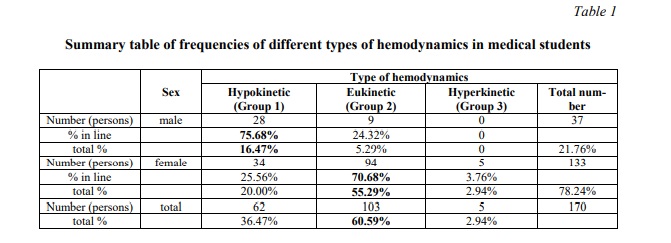
The predominance of the hypokinetic type of hemodynamics in male subjects has also been demonstrated in previous studies [11, 12]. The more common hypokinetic and eukinetic types of blood circulation have evolved from the maintenance of optimal hemodynamics. The hypokinetic type of hemodynamics is believed to be less energy-consuming and associated with the highest functional reserve. A wide range of potential responses to the impact of stress in hypokinetic hemodynamics increases the compensatory capabilities of the cardiorespiratory system [13]. Responses of hyperkinetic hemodynamics are due to positive chronotropic and inotropic effects. This type of hemodynamics in students was associated with the highest values of HR (100.4 (96.5; 109.9)), PP (52.5 (45.0; 60.0)), SV (74.12 (68.6; 79.43)), CO (7.76 (7.64; 7.78)), which generally reflects an energy-consuming functioning of the cardiovascular system with high oxygen consumption and decreases the chronotropic reserve of the cardiovascular system, narrowing the range of responses under stressful conditions.
The results of the analysis of the main heart rate variability parameters in students with different types of hemodynamics are shown in Table 2.
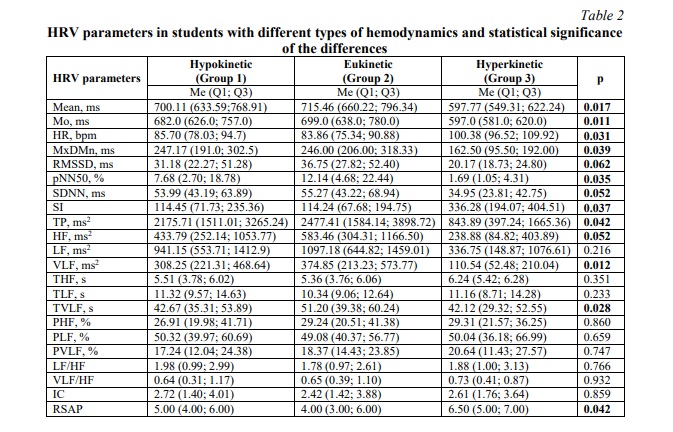
In students with any type of hemodynamics, the following parameters were found to be increased before the exams: PLF (49.08-50.32% vs 15-39%), IC (2.42-2.72 vs 0.9-1.3 c.u.), RSAP (4.0-6.5 vs 1.3 c.u.). SI and PARS values were the highest in students with hyperkinetic hemodynamics, more than twice the upper limit of normal. The predominance of slow waves with a frequency of 0.04-0.15 Hz and an increase in their power relative to the total power of the HRV spectrum, with PLV values significantly above normal, indicates substantial activation of the vasomotor center. High values of the stress index (SI) and the index of centralization (IC) indicate an increase in the tone of the sympathetic nervous system and prevalence of non-respiratory components of sinus arrhythmia over respiratory ones, thus suggesting a predominance of the central regulatory mechanisms over autonomic ones. The revealed specifics of HRV in the study groups are confirmed by a quantitative assessment of the body functioning based on RSAP that characterizes the functional reserves of the body from the viewpoint of environmental adaptation. The RSAP values that were above normal in all study groups indicate a decrease in the functional reserves. Abnormal values of the above-mentioned HRV parameters (showing a significant increase in the sympathetic tone in Group 3) reflect the body’s response to the stressful effects of the pre-examination period in the form of mental, physical and emotional stress. Continuous stress of the systems responsible for homeostasis, especially during the period of preparation for university exams, is a considerable risk factor for the development of disorders and the manifestation of latent abnormalities in students. It has been shown that the level of stress characterized by the HRV in medical students correlates with their academic performance [14]. Obviously, for many students the process of education has an extremely powerful impact that changes stereotypical physiological processes in regulatory systems, which can precede hemodynamic, metabolic, energy disorders and should be detected at the preclinical stage.
The heart rate variability analysis showed that the hypo- and eukinetic types of hemodynamics were associated with relatively more balanced variants of heart function regulation by different parts of the autonomic nervous system based on the SI, IC, PLF and RSAP evidence. These types were associated with higher values of the variation ranges (MxDMn) reflecting the variability of cardiac intervals due to physiological respiratory arrhythmia, a high-frequency (HF) component of the cardiac rhythm spectrum power, as well as Мо, SDNN, RMSSD, pNN50%, as compared to students with hyperkinetic hemodynamics. The total power of the HRV spectrum in subjects with hyperkinetic hemodynamics was significantly below normal (1000-2000 mcs2) and less than half of the respective values in the other groups. The pNN50% value in this group is a prognostic factor for hypertension [15]. Low values of HF that characterizes the parasympathetic regulation may indicate a decrease in myocardial adaptation and metabolism due to reduced vagal protection. A moderate predominance of HF in the HRV spectrum is consistent with the concepts of a protective effect of the vagus nerve on myocardial adaptation and metabolism and is considered physiologically normal since in relative rest, the efficiency of body functions and bioenergetic processes is associated with an increase in parasympathetic regulation and vice versa: the higher the initial level of the sympathetic tone, the more stressed the system and the smaller the adaptive range of reactions induced by stressful factors [6]. In addition, an increased proportion of the power of the lower frequency component (PLF) in the total power may result in hypertension [16].
Although the PVLF values were not significantly different between the groups, the lowest VLF value was observed in subjects with hyperkinetic hemodynamics (U=75; р=0.0049 for Group 2 vs Group 3; U=61; р=0.0223 for Group 1 vs Group 3) (Fig. 1).

Reduced power in the VLF range may be a sensitive indicator of energy deficit (hypoxia, metabolic disorders) and reflects the relationship between the autonomic (segmental) levels of regulation and suprasegmental ones, including the hypothalamic-pituitary and cortical levels [16]. According to some authors, this parameter shows the activity of the sympathetic nervous system [1]. However, in the opinion of N.B. Khaspekova, it demonstrates the cerebral ergotropic effects of the lower regulatory levels and indicates the functional state of the brain [17]. Some experimental data demonstrate that an increase in efferent sympathetic activity clearly increases the amplitude of the VLF rhythm of an individual afferent neuron. The authors concluded that the VLF rhythm generated by the heart itself and is an internal rhythm that seems to be of fundamental importance for health and well-being [18]. Hadase M. et al came to a similar conclusion. The authors noted that although the PVLF, PLF are strong predictors of cardiac events, the VLF determines the onset of a cardiac event independently of the LF, TP, and significant risk factors for cardiac events, such as concomitant diabetes mellitus (DM), plasma brain natriuretic peptide (BNP) level and NYHA functional class [19].
Our comparative analysis of HRV parameters depending on the type of hemodynamics in male and female groups did not reveal significant differences in HRV among male students. However, female students demonstrated differences in the following parameters: HR (p = 0.012), Mean (p = 0.012), Mo (p = 0.009), SI (p = 0.038), VLF (p = 0.025). The highest HR was observed in subjects with hyperkinetic hemodynamics (100.4 (96.5; 109.9) bpm), while Mean (597.76 (549.31; 622.24) ms), Mo (597 (581;620) ms) and VLF (110.5 (52.5; 210.04) ms2) in this group were lowest. The highest stress index value was observed in female subjects with hyperkinetic hemodynamics (336.3 (194.1;404.5)), and the lowest in female subjects with hypokinetic hemodynamics (89.5 (63.3; 213.8)). This indicates a pronounced strain of regulatory systems with a predominance of the activity of central regulatory mechanisms over autonomic ones in subjects with hyperkinetic hemodynamics. Furthermore, given the low VLF index, this also may indicate an energy deficit in the body.
The obtained results demonstrate a significant influence of the cerebral ergotropic effects on the heart rhythm regulation in medical students with different types of hemodynamics during their preparation for exams. With a higher strain of the regulatory system, the effects of the cortical regions of the central nervous system increase and the heart rhythm regulation becomes centralized. The revealed heart rhythm regulation state with a predominance of central regulatory mechanisms was not normal and, although it was observed in all study groups before the exams, appeared more pronounced in female subjects with hyperkinetic hemodynamics.
Next, an analysis of the specifics of heart rate variability in medical students with different types of hemodynamics and body mass index (BMI) values was conducted. Since Group 3 was small and did not include any overweight patients, the parameters of students with normal BMI values were analyzed. Some HRV parameters were shown to differ between subjects with different types of hemodynamics and BMI (Table 3).
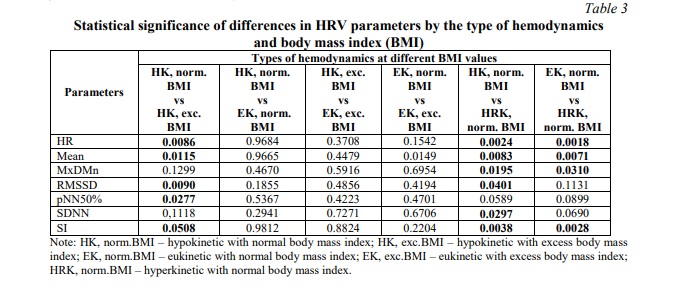
The analysis of characteristics of temporal HRV parameters showed that subjects with hypokinetic and eukinetic hemodynamics and excessive BMI have higher HR, and it is the highest in subjects with the hyperkinetic type even if the BMI is within the normal range (Fig. 2).
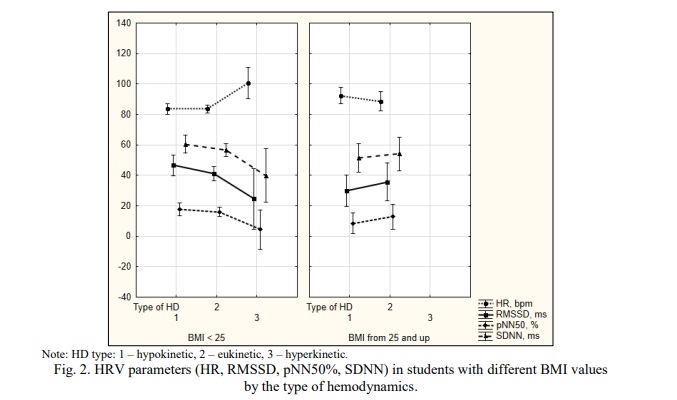
The standard deviation of the NN intervals is known to be related to both the autonomic regulatory pathway and the central one; a decrease is usually associated with an increase in the sympathetic regulation, which inhibits the activity of the autonomic pathway [10]. The sharp SDNN decrease revealed in our study in students with hyperkinetic hemodynamics was associated with a significant strain experienced by the regulatory systems, when higher control levels are activated and almost completely inhibit the autonomic pathway. The similar changes observed in RMSSD, pNN50%, parameters associated with the effect of respiration on the cardiac interval duration, and their abrupt decrease in subjects with hyperkinetic hemodynamics even with normal BMI confirm a decrease in the parasympathetic nervous system activity.
RMSSD, pNN50% in overweight students with hypokinetic hemodynamics were significantly lower compared to the students with normal body mass, therefore, the activity of the parasympathetic nervous system was also lower. By analyzing 5-min HRV recordings, Koenig J. et al showed that the balance between the sympathetic and vagal regulation correlates with the BMI, which is inversely proportional to pNN50 and RMSSD, indicating the important role of the vagus nerve in the modulation of energy consumption in the human body [20]. Similar results were obtained in another study [21]. It was noted in [22] that overweight individuals have a sympathovagal imbalance, which is characterized by an increase in the LH/HF ratio.
The mean duration of cardiac intervals (Mean) and the difference between the maximum and minimum values of cardiac intervals (MxDMn) are dramatically reduced in individuals with hyperkinetic hemodynamics, even with normal BMI (Fig. 3). These changes in MxDMn and the values of this parameter over the eutonic range (200-300 ms) show that sympathetic activity prevailed in the autonomic balance of the study subjects with hyperkinetic hemodynamics. The regulatory system stress index, on the contrary, increased significantly with the hyperkinetic type of hemodynamics, significantly exceeding the normal level (70-150 conv. un.).
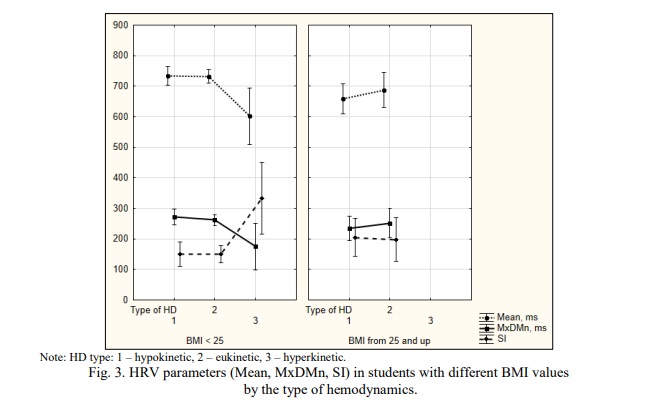
SI values in overweight students with hypokinetic hemodynamics were also above normal (up to 204.9 (121.75; 288.19) conv. un.), while in the students with normal body weight they were at the upper limit of normal (150.4 (114.15; 186.61) conv. un.). This indicates an increase in sympathetic regulation and a predominance of the activity of central regulatory mechanisms over autonomic ones in overweight students with hypokinetic hemodynamics. HRV studies in obese children and adolescents showed an autonomic imbalance characterized by a decrease in HF in short-term time-domain variables and an increase in the LF power of HRV [23, 24, 25]. Moreover, the autonomic system suppression correlates with the duration of obesity and can itself be a physiological factor contributing to its development [26]. HRV monitoring has been suggested for use in weight loss programs as an additional tool for analyzing the general state of health and homeostasis, where an improvement would be indicated by a decrease in heart rate and an increase in SDNN [27]. Nowadays, with the active development of Remote Measurement Technologies (RMT), HRV may be an additional digital biomarker for neurovisceral digital phenotyping, supplementing data obtained with existing clinical methods, which contributes to a holistic approach that combines known markers with achievements in the field of remote digital technologies [28].
Conclusion. The predominant types of hemodynamics in our study were eukinetic and hypokinetic. The HR, PP, SV, CO values were higher, while the mean DBP and BP were lower in subjects with hyperkinetic hemodynamics compared to those with hypokinetic hemodynamics. During the preparation for exams, medical students demonstrated a significant increase in the following parameters: SI, IC and RSAP. The highest SI and RSAP values were observed in students with hyperkinetic hemodynamics, indicating an increase in the tone of the sympathetic nervous system and a predominance of non-breathing-related components of sinus arrhythmia over breathing-related ones, as well as a predominance of the central regulatory mechanisms over autonomic ones.
The autonomic regulation of cardiovascular function in students with different type of hemodynamics is achieved in different ways. In students with hypokinetic hemodynamics, the sympathetic nervous system and, to some extent, central regulatory mechanisms are involved in the regulation of cardiovascular function, although not as much as in subjects with the hyperkinetic type. Proper function of the cardiovascular system in subjects with hyperkinetic hemodynamics, from the HRV standpoint, is associated with pronounced activation of the sympathetic nervous system and the central regulatory pathway, with the involvement of suprasegmental CNS pathways. HRV data in students with eukinetic hemodynamics are close to those in subjects with the hypokinetic type. Some HRV parameters worsen with higher BMI in students with different types of hemodynamics, indicating a state of adaptive strain and predicting cardiovascular dysfunction.
The higher occurrence of eukinetic and hypokinetic hemodynamics (less energy-consuming compared to the hyperkinetic type) may indicate an involvement of adaptive mechanisms of cardiovascular function during the preparation for exams.




















Список литературы
Список использованной литературы появится позже.